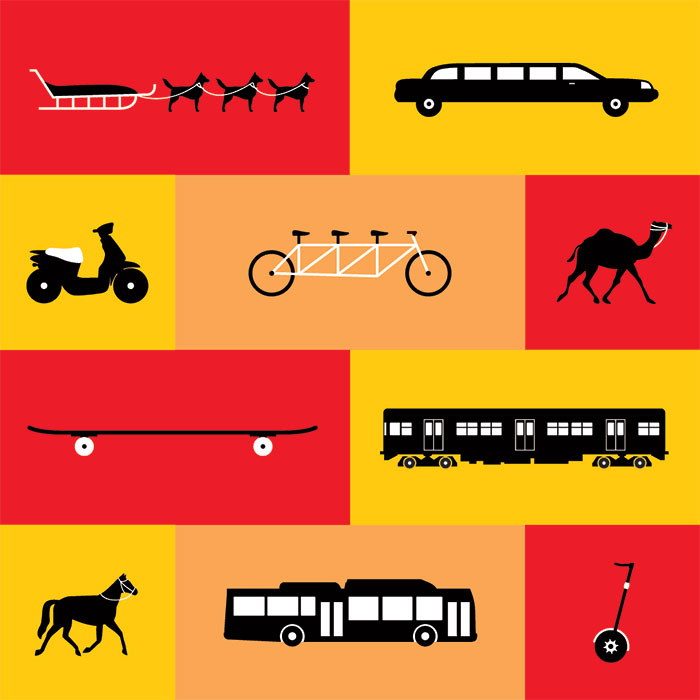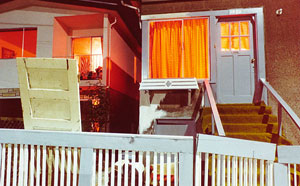Transit, for most hardened commuters, is about conveyance: the (hopefully swift) and frequently crowded journey between points on the urban compass. But once in a while, we look up from our smart phones and comprehend that these complex transportation systems in our midst are destinations in their own right, pulsating with mechanical beauty and the energy of crowds.
Little children, enthralled by the prospect of boarding life-sized train sets, intuitively understand the clattering fascination of subways and streetcars. For the traveller, the most authentic experience of arriving in a foreign city often begins, not with a cab ride to the hotel, but by deciphering the vernacular of the local transit system and melting anonymously into the platform’s throng. London is nowhere more like its authentic self than in the magnificently chaotic train and tube stations that function, truly, like the city’s heart muscles.
Montreal travel writer and freelance journalist Taras Grescoe understands the romance of the journey better than most, having penned four books documenting his world-beating adventures in locations that run the gamut from the gritty to the exotic. In his latest work, Straphanger, he has produced a travelogue about that most quotidian, and perhaps overlooked, form of travel: the daily commute. In visits to metropolises from Tokyo to Bogotá, he discovers that much of the social life of cities plays out in and around the subway tunnels and streetcars and bike lanes that enable urban dwellers to get from point A to point B.
Urban experts, of course, have long understood that transit systems do far more than shunt people around at rush hour. Grescoe’s narrative, however, is as much about people as it is about planning. In city after city, he explores how the history of urban transit is riddled with street-level conflict, commercial scheming, and soaring political aspirations. He also demonstrates how, in some places, transit has become an immensely powerful agent of social change, countering the centrifugal force of that other great twentieth-century transportation technology: the car.
When private operators began digging subways into Brooklyn in the early 1900s, they “decanted… the teeming, insalubrious tenements of the Lower East Side to the farthest corners of the boroughs,” he writes. The new service, in effect, helped thousands of New Yorkers to literally escape from poverty, but it also created the conditions that allowed commercial developers to erect office towers in Lower Manhattan, safe in the knowledge that they would attract commuters from the outer boroughs: “Because it was able to move so many people so quickly, the subway became the ultimate urban density amplifier.” New York, he says, is New York precisely because of its subway system.
In the beginning, though, the subway was hotly opposed by Manhattan landowners and Tammany Hall, the corrupt political machine that controlled city hall for decades and had a financial stake in New York’s streetcar network. Although the points of friction may be different, epic fights over urban transit systems persist to this day, judging by the bruising showdowns over downtown highways, bike lanes, and light rail transit (LRT) schemes that plague many crowded cities. Almost all urban dwellers harbour strong (genuine? self-interested?) feelings about the configuration of their local transportation networks. And so they should: the decisions affect everything from development patterns to productivity levels to shopping habits. Richard Florida further argues that dense, transit-reliant cities tend to attract creative, tolerant people. Grescoe, who has contributed to the New York Times and this magazine, argues convincingly that cities that bet on bike lanes and street-level transit have happier, healthier, more sociable residents than those that have tethered themselves to the insatiable needs of the private automobile.
In short, the stakes are high, and getting higher, for our increasingly urban planet. A few years back, the world passed a historic threshold: more than 50 percent of the global population now lives in cities. This moment, in some ways, evokes the super-congested state of nineteenth-century industrial age cities like New York—conditions that prompted entrepreneurs and land speculators to build subways, and enticed working people to abandon slow-moving carriages (or the rattling elevated railways that criss-crossed Manhattan). It wasn’t about policy so much as the profit motive; government ownership and “transit planning” came later.
Land speculation and transit construction have long proceeded in lockstep, yielding relatively compact and walkable streetcar suburbs (Toronto, Portland, and even Los Angeles), as well as the dense mixed-use satellites developed by powerful Japanese rail and real estate consortia on Tokyo’s fringes to ensure destinations for their commuter passengers. In Vancouver, where planning is treated like a sacred ritual, clusters of commercial, institutional, and condo developments have cropped up at the SkyTrain stations.
Even so, pitched battles over transit planning often focus on the arrow of causation: does transit infrastructure attract development, or is a certain threshold of urban density required to justify the cost of major transit projects? The corollary problem is whether the ensuing development around transit nodes generates mixed-income communities, the holy grail of urbanism, or soulless clusters of high-rises. These are loaded questions with no easy answers. Because the development that accumulates along transit corridors takes decades to mature, no one really knows how the wine will turn out.
Like a growing number of urbanists, Grescoe throws in his lot with cities that focus on surface transit and non-motorized transportation (feet, pedals). He clearly admires the historic subways—and subway culture—of New York and Paris, and Moscow, where Stalin’s baroque stations lie deep beneath the city’s preposterously occluded arteries. But Grescoe believes that the residents of twenty-first-century cities must find new ways to fairly apportion the space on roads among different users.
His view is rooted in a deep-seated antipathy toward private cars: he once witnessed a horrible accident on a highway, and vowed that automobiles would not be “a major part” of his life. That may seem eccentric for someone who lives in a country as large as Canada, but, as Grescoe knows, the vast majority of the world’s inhabitants don’t own cars. Large swaths of the populations of teeming, modern cities, such as New York, Toronto, and London, rely instead on transit. In the megacities of Asia, Latin America, and Africa, transit is a survival mechanism because rising private car ownership is overwhelming road infrastructure.
Much of Straphanger focuses on cities that have succeeded in moving beyond the idea that the space between sidewalks is the almost exclusive purview of private and commercial vehicles. Thanks to visionary Danish planner Jan Gehl, Copenhagen has systematically reclaimed the once-gridlocked streets of the inner city as a pedestrian-only zone. But the bigger story is the parallel growth of that city’s extensive bike infrastructure, a broad network of bike lanes that has spawned a city-wide cycling culture embraced by all ages, from students to business people to seniors. In Copenhagen, virtually everyone rides. And it’s not strange.
Gehl’s influence can now be seen in cities as diverse as New York and Melbourne, where gutsy political leaders have taken road allowances away from vehicular traffic. In Bogotá, Grescoe documents the remarkable story of how a pair of forward-thinking mayors not only created one of the world’s busiest bus rapid transit networks, but also triggered something of an urban cycling renaissance by adding hundreds of kilometres of bike paths. Sundays are car-free on Bogotá’s major arteries. For Grescoe, this is about taking back the streets from the gangster-owned vehicles that roared through the city as if they owned the place (a dynamic he also observes in Moscow). Revealing an urban-minded populism, Mayor Enrique Peñalosa explains that Bogotá’s bike paths “showed that a cyclist on a $30 bike was equally important as a citizen in a $30,000 car.” Those, surely, are the words of a politician who knows how to count votes.
Running parallel to the cycling revolution in cities like Bogotá and Copenhagen is the runaway popularity of light rail as an alternative to its far more costly ancestor, the subway. The reason is not difficult to fathom: when building rapid transit in newer and lower-density suburban areas, municipalities invariably get more bang for their transit buck with LRTs than with subways, as LA has realized over the past three years. Indeed, according to a suppressed Toronto Transit Commission report, there are 115 LRT projects currently under construction worldwide. (Grescoe neglects to mention that Calgary and Edmonton were pathfinders in this regard, building LRTs back in the late 1970s, when the technology was in its infancy.)
Some earlier LRTs in American cities such as LA and Phoenix failed because they were shunted through derelict neighbourhoods with little traffic, few riders, and scant political opposition. Other cities, like central Portland and Philadelphia, have seen older streetcar neighbourhoods flourish in recent years because they have enough urbanity to attract hipster boutiques and galleries and gentrifiers. But newer and more compact suburban communities built around LRT stations, such as Orenco Station on the outskirts of Portland, lack a certain something, even if they are more walkable than traditional subdivisions. People in Orenco, as Grescoe observes, still do a lot of driving, despite the LRT.
Indeed, it’s very much an open question as to whether modern LRTs will eventually spawn the kind of intimate neighbourhoods and main streets that developed organically around early streetcar lines. To many traffic-addled suburbanites in Toronto, where this particular debate has raged like a brush fire for the past four years, such abstractions take a back seat to the more pressing issue of whether a dedicated LRT right-of-way running down the middle of a busy artery will only make gridlock that much more annoying. Activists like to say that well-executed transit investments will make the roads less busy—an urban “decongestant,” as one long-time Toronto politician often put it. But for all its internal logic, that message tends to get lost in traffic jams that only seem to worsen.
For Grescoe, the issue ultimately comes down to personal choice: “I believe the place you choose to live in says a lot about who you are,” he writes, by way of explaining his decision to settle with his wife in the Montreal borough of Outremont, another early twentieth-century streetcar suburb chockablock with urban authenticity. But I would argue that where you choose to live says as much about what you do and how much you make as it reveals about any sense of principle. Many people, recent immigrants included, settled in sprawling postwar suburbs because that was all they could afford. And because most North American cities were built with the private vehicle as the organizing ideology, the task of bringing transit service to these areas is difficult and costly. It was not a question of choice so much as the lack thereof.
The postwar suburbs—and not communities friendly to transit, cycling, and pedestrians (such as Outremont)—represent the urban landscapes where the twenty-first-century transit renaissance Grescoe describes will meet their most formidable challenge. In Paris, the Sarkozy government has pledged to spend vast sums in coming years to extend the metro out to the banlieues that lie beyond the city’s ring road. Vancouver has staked its future growth on using the SkyTrain stations to focus and concentrate suburban growth. Other cities have turned to bus rapid transit to provide cost-effective alternatives to gridlock. (Toronto, it seems, will continue to bicker about the relative merits of suburban subways and LRT for some time to come.)
None of these decisions, it must be said, are slam dunks: the investments are huge, and the dividends—social, commercial, and logistical—can take decades, or more, to materialize. But one point remains clear: as well as carrying passengers between jobs, schools, and shopping districts, thoroughly networked transit systems have the potential to propel our increasingly populous cities toward a more sustainable, and livable, footing. The debate is about much more than the ride home.
This appeared in the May 2012 issue.




